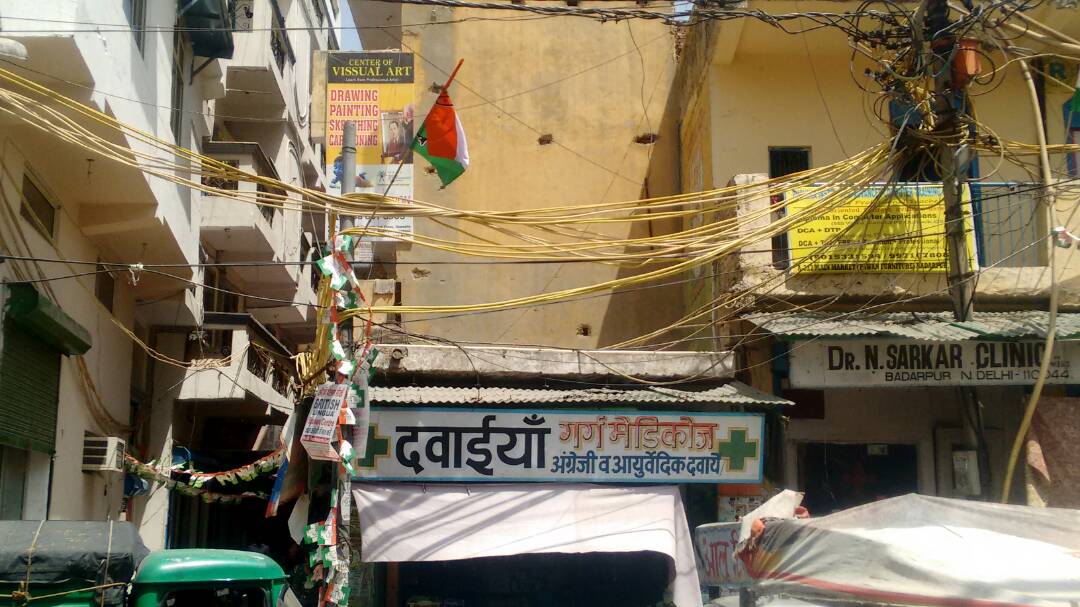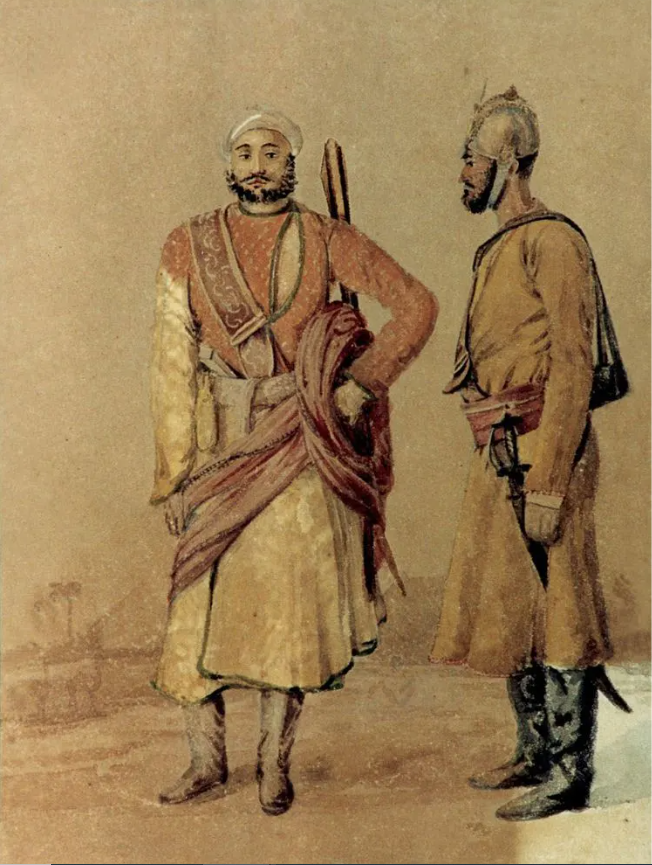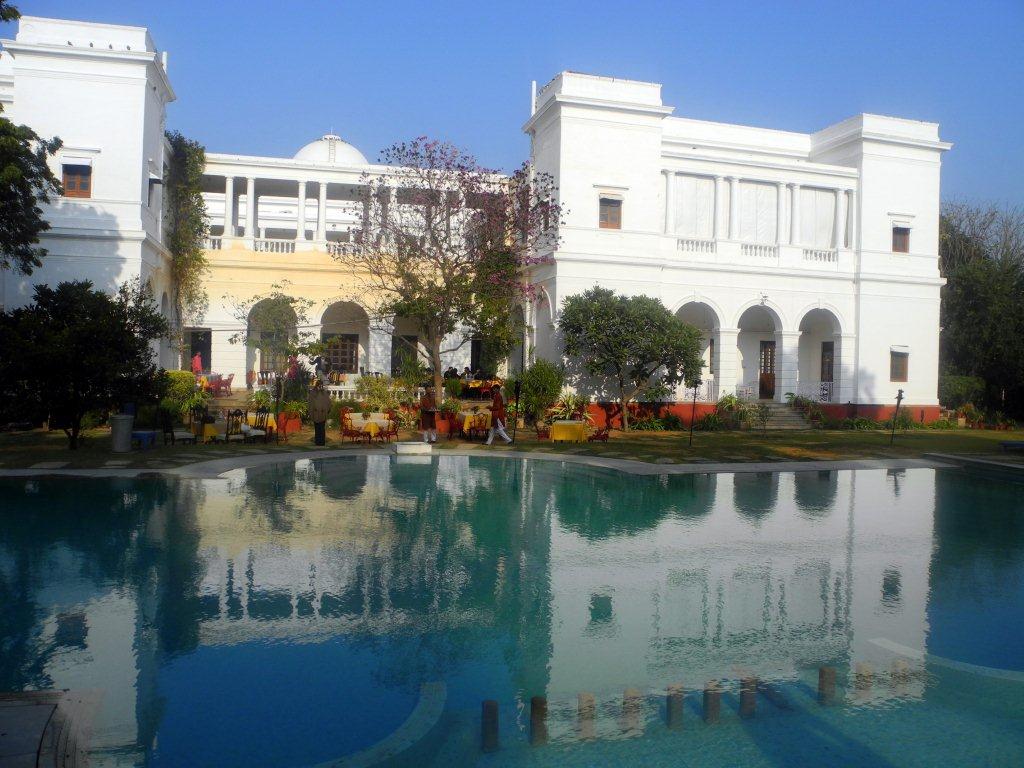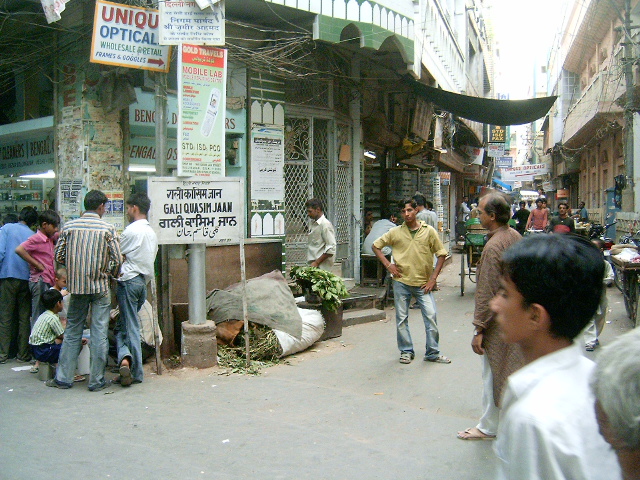|
Raja Nahar Singh
Raja Nahar Singh (died 1858) was a Jat Ruler of the princely state of Ballabhgarh in Faridabad District of Haryana, India . He fought The East India Company in the Indian Rebellion of 1857. The small kingdom of Ballabhgarh is only 20 miles from Delhi. Nahar Singh Stadium in Faridabad is named after him. The Raja Nahar Singh metro station in Violet line is also named after him . History and family Ballabhgarh Village was a village headed by Tewatia clan. Balram Singh Tewatia was the first ruler of Ballabhgarh State, and Nahar Singh was his descendant. His teachers included Pandit Kulkarni and Maulvi Rahman Khan. His father died in 1830, when he was about 9 years old. Nahar Singh was crowned in 1839. Liberal ruler He was an able and secular ruler who promoted communal harmony, his letter (31 July 1857) to Mughal Emperor Bahadur Shah Zafar says: He even made a gift of 4 villages to his Muslim court musician Umra Khan of Delhi gharana, a gift that included "the village of mel ... [...More Info...] [...Related Items...] OR: [Wikipedia] [Google] [Baidu] |
Raja
''Raja'' (; from , IAST ') is a royal title used for South Asian monarchs. The title is equivalent to king or princely ruler in South Asia and Southeast Asia. The title has a long history in South Asia and Southeast Asia, being attested from the Rigveda, where a ' is a ruler, see for example the ', the "Battle of Ten Kings". Raja-ruled Indian states While most of the Indian salute states (those granted a gun salute by the British Crown) were ruled by a Maharaja (or variation; some promoted from an earlier Raja- or equivalent style), even exclusively from 13 guns up, a number had Rajas: ; Hereditary salutes of 11-guns : * the Raja of Pindrawal * the Raja of Morni * the Raja of Rajouri * the Raja of Ali Rajpur * the Raja of Bilaspur * the Raja of Chamba * the Raja of Faridkot * the Raja of Jhabua * the Raja of Mandi * the Raja of Manipur * the Raja of Narsinghgarh * the Raja of Pudukkottai * the Raja of Rajgarh * the Raja of Sangli * the Raja of Sailana * the Raj ... [...More Info...] [...Related Items...] OR: [Wikipedia] [Google] [Baidu] |
1857 Uprising
The Indian Rebellion of 1857 was a major uprising in India in 1857–58 against Company rule in India, the rule of the East India Company, British East India Company, which functioned as a sovereign power on behalf of the The Crown, British Crown. The rebellion began on 10 May 1857 in the form of a mutiny of sepoys of the Company's army in the garrison, garrison town of Meerut, northeast of Delhi. It then erupted into other mutinies and civilian rebellions chiefly in the Ganges Basin, upper Gangetic plain and central India, though incidents of revolt also occurred farther north and east. The rebellion posed a considerable threat to British power in that region, and was contained only with the rebels' defeat in Gwalior on 20 June 1858., , and On 1 November 1858, the British granted amnesty to all rebels not involved in murder, though they did not declare the hostilities to have formally ended until 8 July 1859. Its Names of the Indian Rebellion of 1857, name is contested, an ... [...More Info...] [...Related Items...] OR: [Wikipedia] [Google] [Baidu] |
Palwal
Palwal is a city and a municipal council. It is the headquarters of Palwal district, the 21st district of Haryana state in northern India. It is a centre of the cotton trade in the area. It is also a part of National Capital Region. Etymology and legend The origin of Palwal is related to the local legend related to the Mahabharata, according to which the town is named after an asura called ''"Palwasura"'' who was slain by Balarama, the brother of Krishna. To commemorate this event an annual festival called ''"Baldev Chhat Ka Mela"'' is held here, and a ''"Dauji temple"'' in honor of Balrama is situated in Banchari village 25 km from Palwal on Grand Trunk Road. History The local tradition identifies Palwal with the Apelava town mentioned in the Mahabharata, which was later restored by Vikramaditya. Matia Fort or ''Palwal Fort'' was built during the Sher Shah Suri's time. Excavations have unearthed evidence of a grand palace at the bottom of the fort. As of 2021, it ... [...More Info...] [...Related Items...] OR: [Wikipedia] [Google] [Baidu] |
Pali Village
Pali is an Indian village in the NIT area of Faridabad city of Faridabad district under Faridabad Lok Sabha constituency of Haryana state, well known for being biggest crusher zone of Asia, that also has a seasonal waterfall. It is the part of the Northern Aravalli leopard wildlife corridor, an important wildlife corridor which starts from the Sariska National Park in Rajasthan, passes through Nuh, Faridabad and Gurugram districts of Haryana and ends at Delhi Ridge.Haryana Government moots buffer zone to save Asola sanctuary Times of India, 30 Jan 2019. The village is now a southwestern suburb of |
Pargana
Pargana ( bn, পরগনা, , hi, परगना, ur, پرگنہ) or parganah, also spelt pergunnah during the time of the Sultanate period, Mughal times and British Raj, is a former administrative unit of the Indian subcontinent and each ''Parganas'' may or may not subdivided into some ''pirs''. Those revinue units are used primarily, but not exclusively, by the Muslim kingdoms. After independence the Parganas became equivalent to Block/ Tahsil and Pirs became Grampanchayat. ''Parganas'' were introduced by the Delhi Sultanate. As a revenue unit, a pargana consists of several '' mouzas'', which are the smallest revenue units, consisting of one or more villages and the surrounding countryside. Under the reign of Sher Shah Suri, administration of parganas was strengthened by the addition of other officers, including a '' shiqdar'' (police chief), an ''amin'' or ''munsif'' (an arbitrator who assessed and collected revenue) and a ''karkun'' (record keeper). Mughal era In the ... [...More Info...] [...Related Items...] OR: [Wikipedia] [Google] [Baidu] |
Badarpur, Delhi
Badarpur is a historic town in South East Delhi district in Delhi. Badarpur is famous for its Badarpur Border bus terminal. It is also serviced by Badarpur Border station of Delhi Metro on Violet Line. The bus terminal and metro station have been renamed by Delhi Government as 'Badarpur border'.There is another bus terminal from Faridabad Side namely Badarpur border Bus terminal from Haryana roadways and UP parivahan buses and Echo vans goes for Southern Haryana and Western Uttar Pradesh. It is situated on Mathura Road joining Delhi with Mathura and Agra, on NH 2 (Delhi-Kolkata) National Highway, a part of the historic Grand Trunk Road that once joined Bengal to Kabul. It is the starting point for the on the "Mehrauli- Badarpur Road" that passed through Tughlaqabad, Khanpur, Tigri and Saket towards Mehrauli. The Delhi Faridabad Skyway elevated highway also opened at the starting of Mehrauli- Badarpur Road. Badarpur is also home to the Badarpur Thermal Power Station (BTPS ... [...More Info...] [...Related Items...] OR: [Wikipedia] [Google] [Baidu] |
Delhi Gate, Delhi
Delhi Gate of Naman is the southern gate in the historic walled city of Delhi, or Shahjahanabad in 1638 AD. The gate links the New Delhi city with the old walled city of Delhi. It stands in the middle of the road, at the end of Netaji Subhash Chandra Road (or Netaji Subhash Marg), at the edge of Daryaganj. History The Gate was built by Emperor Shah Jahan in 1638 as part of the rubble– built high fort walls that encircled the Shahjahanabad, the seventh city of Delhi. The emperor used this gate to go to the Jama Masjid for prayer. Architecture The gate is similar in design and architecture to the northern gate of the walled city, the Kashmiri Gate (1853). It was built in sandstone and is an impressive and large structure. Near the gate entry, two stone carvings of elephants were erected. The road from this gate passes through Daryaganj leading to the Kashmiri gate. A part of the fort wall to the east has been demolished to build the Old Delhi Railway Station wh ... [...More Info...] [...Related Items...] OR: [Wikipedia] [Google] [Baidu] |
Bahadur Shah Zafar
Bahadur Shah II, usually referred to by his poetic title Bahadur Shah ''Zafar'' (; ''Zafar'' Victory) was born Mirza Abu Zafar Siraj-ud-din Muhammad (24 October 1775 – 7 November 1862) and was the twentieth and last Mughal Emperor as well as an Urdu poet. He was the second son and the successor to his father, Akbar II, who died on 28 September 1837. He was a titular Emperor, as the Mughal Empire existed in name only and his authority was limited only to the walled city of Old Delhi (Shahjahanbad). Following his involvement in the Indian Mutiny of 1857, the British exiled him to Rangoon in British-controlled Burma in 1858, after convicting him on several charges. Bahadur Shah Zafar's father, Akbar II, had been imprisoned by the British and he was not his father's preferred choice as his successor. One of Akbar Shah's queens pressured him to declare her son, Mirza Jahangir, as his successor. However, The East India Company exiled Jahangir after he attacked their resident in ... [...More Info...] [...Related Items...] OR: [Wikipedia] [Google] [Baidu] |
Pali, Rajasthan
Pali is a city in Rajasthan state of India. It is the administrative headquarters of Pali District and comes in the Marwar region. It is on the bank of the river Bandi and is south east of Jodhpur. It is known as "The Industrial City". History Pali (formerly known as Pallika and Palli) was a trade centre. In the 11th century AD, Pali was ruled by the Guhilas of Mewar. In the 12th century it became a part of the Nadol kingdom and was ruled by the Chauhans. In 1153 AD it was ruled by Kumarapala and his feudatory Vahadadeva. Then it came under possession of Songara Chauhans of Jalore. The Rathore dynasty chronicles relate that Siyaji or Sheoji, grandson of Chandra, the last Gahadvala Rathore king of Kannauj, came to Marwar on a pilgrimage to Dwarka in Gujarat, and on halting at the town of Pali he and his followers settled there to protect the Brahmin community from the raids of marauding bands. His devali with the inscription of 1273 AD was discovered 21 km n ... [...More Info...] [...Related Items...] OR: [Wikipedia] [Google] [Baidu] |
Kushal Singh Of Auwa
Kushal Singh Champawat Rathore also known as Khushal Singh Champawat (died 1864) was the Thakur of a prominent Thikana of Auwa in Jodhpur State. During Indian rebellion of 1857, he defeated the British Army in the Battle of Bithoda and chelawas. Role in Indian Rebellion of 1857 Kushal Singh, who was in open rebellion, invited the rebel soldiers of Jodhpur legion to Auwa who were marching from Mount Abu to Delhi. The Thakurs of Asop, Bajawas, Gular and Alaniawas also joined Thakur Kushal Singh at Auwa to put combined effort. The Agent of Governor General of Rajputana General Lawrence when hearing of the news of the rebellion asked Maharaja of Jodhpur to collect an army and march towards Auwa. The Jodhpur state army half-heartedly marched, furious General Lawrence sent Lt. Heathcote to encourage the men to attack Auwa. Battle of Bithoda Kushal Singh at the head of the rebel army marched to meet the state army near Bithoda, where a battle ensued and the state army fled along with ... [...More Info...] [...Related Items...] OR: [Wikipedia] [Google] [Baidu] |
Pataudi State
Pataudi State was a small princely state in India, established in 1804 during the East India Company rule in India. The state formed a part of the Delhi Territory in the Ceded and Conquered Provinces. It was under the suzerainty of the Commissioner of Delhi. It had an area of 52 square miles and included one town, Pataudi, and 40 villages, ruled by the Pataudi family. History The state of Pataudi was established in 1804 by the British East India Company, when Faiz Talab Khan, an Afghan Muslim Pashtun of the Barech tribe, who was made the first Nawab, aided them in their battle against the Maratha Empire, during the Second Anglo-Maratha War. The family traces their origin to 16th century India, when their ancestors immigrated from present day Afghanistan to India during the period of the Lodi dynasty. The 8th Nawab, Iftikhar Ali Khan Pataudi, played cricket for both England and India and captained the latter. His son the last Nawab also captained the Indian cricket team. At t ... [...More Info...] [...Related Items...] OR: [Wikipedia] [Google] [Baidu] |
Loharu State
Loharu State was one of the princely states of India during the period of the British Raj. It was part of the Punjab States Agency and was a nine-gun salute state. Loharu State encompassed an area of , and was situated in the south-east corner of the undivided Punjab province, between the district of Hissar and the Rajputana Agency. In 1901, the state had a population of 15,229 people, of whom 2,175 resided in the town of Loharu. From 1803 to 1835, the territory of Loharu State also included an Ferozepur Jhirka enclave within the area directly administered by the British raj, Outer limits of the state were defined by the peripheral towns of Loharu, Bahal, Isharwal, Kairu, Jui Khurd and Badhra. The ''haveli'' of 'Nawab of Loharu', known as ''Mahal Sara'', lies in Gali Qasim Jan in Ballimaran, where his son-in-law, noted poet Mirza Ghalib stayed for a few years, whose own Ghalib ki Haveli lies a few yard away. Now the '' gali'', which houses the Mahal Sara, is known as ''Kothi ... [...More Info...] [...Related Items...] OR: [Wikipedia] [Google] [Baidu] |






